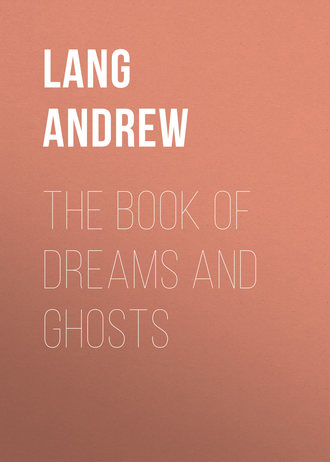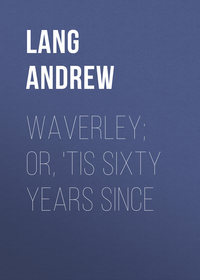 полная версия
полная версияThe Book of Dreams and Ghosts
71
Life of Lockhart.
72
The author has given authorities in Blackwood’s Magazine March, 1895. A Mr. Coulton (not Croker as erroneously stated) published in the Quarterly Review, No. 179, an article to prove that Lyttelton committed suicide, and was Junius. See also the author’s Life of Lockhart.
73
A prominent name among the witnesses at the trial.
74
The report of the trial in the Scots Magazine of June, 1754 (magazines appeared at the end of the month), adds nothing of interest. The trial lasted from 7 a.m. of June 11 till 6 a.m. of June 14. The jury deliberated for two hours before arriving at a verdict.
75
Sydney, no date.
76
Phantasms, ii., 586, quoting (apparently) the Buckingham Gazette of the period.
77
Oddly enough a Mr. William Soutar, of Blairgowrie, tells a ghost story of his own to the S.P.R.!
78
I put them for convenience at the foot. – W. L. L.
79
The dogs in all these towns (farms) of Mause are very well accustomed with hunting the fox.
80
Blair (Blairgowrie) is the kirk-town of that parish, where there is also a weekly market: it lies about a mile below Middle Mause on the same side of the river.
81
Knockhead is within less than half a mile of Middle Mause, and the Hilltown lies betwixt the two. We see both of them from our window of Craighall House.
82
This George Soutar died about two or three years ago, and was very well known to William.
83
The Isle is a spot of ground in the wood of Rychalzie, about a mile above Middle Mause, on the same side of the river.
84
Glasclune is a gentleman of the name of Blair, whose house lies about three-quarters of a mile south-west from Middle Mause.
85
He said the voice answered him as if it had been some distance without the door.
86
Besides the length of time since the murder was committed, there is another reason why all the bones were not found, viz., that there is a little burn or brook which had run for the space of twenty years, at least, across upon the place when the bones were found, and would have carried them all away had it not been that the bush, at the side of which they were buried, had turned the force of the stream a little from off that place where they lay, for they were not more than a foot, or at most a foot and a half, under ground, and it is only within these three years that a water-spate has altered the course of the burn.
87
The course of the river (the Ericht) is from north to south. Middle Mause lies on the west side of it, and Craighall on the east.
88
With reference to the last statement in Mr. Newton’s notes see the Journal of Sir Walter Scott (edit., 1891, p. 210) under date 13th June, 1826.
89
L’Homme Posthume.
90
Denny’s Folklore of China.
91
Story received in a letter from Lieutenant – of H.M.S gunboat – .
92
He fought at Culloden, of course for King George, and was appealed to for protection by old Glengarry.
93
Fox’s hole.
94
How did Inverawe get leave to wear the Highland dress?
95
In every version of the story that I have heard or read Ticonderoga is called St. Louis, and Inverawe was ignorant of its other name. Yet in all the histories of the war that I have seen, the only name given to the place is Ticonderoga. There is no mention of its having a French name. Even if Inverawe knew the fort they were to storm was called Ticonderoga, he cannot have known it when the ghost appeared to him in Scotland. At that time there was not even a fort at Ticonderoga, as the French only erected it in 1756. Inverawe had told his story to friends in Scotland before the war broke out in America, so even if in 1758 he did know the real name of the fort that the expedition was directed against, I don’t see that it lessens the interest of the story. – E. A. C.
The French really called the place Fort Carillon, which disguised the native name Ticonderoga. See Memoirs of the Chevalier Johnstone. – A. L.
96
Abercromby’s force consisted of the 27th, 42nd, 44th, 46th, 55th, and battalions of the 60th Royal Americans, with about 9000 Provincials and a train of artillery. The assault, however, took place before the guns could come up, matters having been hastened by the information that M. de Lévy was approaching with 3000 French troops to relieve Ticonderoga garrison.
97
I know one inveterate ghost produced in an ancient Scottish house by these appliances. – A. L.
98
Such events are common enough in old tales of haunted houses.
99
This lady was well known to my friends and to Dr. Ferrier. I also have had the honour to make her acquaintance.
100
Apparently on Thursday morning really.
101
She gave, not for publication, the other real names, here altered to pseudonyms.
102
Phantasms, ii., 202.
103
Maspero, Etudes Egyptiennes, i., fascic. 2.
104
Examples cited in Classical Review, December, 1896, pp. 411, 413.
105
Proceedings, S.P.R., vol. xii., p. 45-116.
106
See “Lord St. Vincent’s Story”.
107
Anecdote received from the lady.
108
Story at second-hand.
109
See The Standard for summer, 1896.
110
I have once seen this happen, and it is a curious thing to see, when on the other side of the door there is nobody.
111
S.P.R., iii., 115, and from oral narrative of Mr. and Mrs. Rokeby. In 1885, when the account was published, Mr. Rokeby had not yet seen the lady in grey. Nothing of interest is known about the previous tenants of the house.
112
Proceedings, S.P.R., vol. viii., p. 311.
113
Letter of 31st January, 1884.
114
Six separate signed accounts by other witnesses are given. They add nothing more remarkable than what Miss Morton relates. No account was published till the haunting ceased, for fear of lowering the letting value of Bognor House.
115
Mr. A. H. Millar’s Book of Glamis, Scottish History Society.
116
This account is abridged from Mr. Walter Leaf’s translation of Aksakoff’s Predvestniki Spiritizma, St. Petersburg, 1895. Mr. Aksakoff publishes contemporary letters, certificates from witnesses, and Mr. Akutin’s hostile report. It is based on the possibility of imitating the raps, the difficulty of locating them, and the fact that the flying objects were never seen to start. If Mrs. Shchapoff threw them, they might, perhaps, have occasionally been seen to start. S.P.R., vol. xii., p. 298. Precisely similar events occurred in Russian military quarters in 1853. As a quantity of Government property was burned, official inquiries were held. The reports are published by Mr. Aksakoff. The repeated verdict was that no suspicion attached to any subject of the Czar.
117
The same freedom was taken, as has been said, with a lady of the most irreproachable character, a friend of the author, in a haunted house, of the usual sort, in Hammersmith, about 1876.
118
Proceedings, S.P.R., vol. xii., p. 49.
119
John Wesley, however, places Hetty as next in seniority to Mary or Molly. We do not certainly know whether Hetty was a child, or a grown-up girl, but, as she always sat up till her father went to bed, the latter is the more probable opinion. As Hetty has been accused of causing the disturbances, her age is a matter of interest. Girls of twelve or thirteen are usually implicated in these affairs. Hetty was probably several years older.
120
30th January, 1717.
121
Glanvil’s Sadducismus Triumphatus, 1726. Preface to part ii., Mompesson’s letters.
122
Gentleman’s Magazine, November, December, 1872.
123
This happened, to a less degree, in the Wesley case, and is not uncommon in modern instances. The inference seems to be that the noises, like the sights occasionally seen, are hallucinatory, not real. Gentleman’s Magazine, Dec., 1872, p. 666.
124
S.P.R. Proceedings, vol. xii., p. 7.
125
Demon Possession in China, p. 399. By the Rev. John L. Nevius, D.D. Forty years a missionary in China. Revel, New York, 1894.
126
Translated from report of Hsu Chung-ki, Nevius, p. 61.
127
Nevius, pp. 403-406.
128
Op. cit., p. 415. There are other cases in Mr. Denny’s Folklore of China.
129
The Great Amherst Mystery, by Walter Hubbell. Brentano, New York, 1882. I obtained some additional evidence at first hand published in Longman’s Magazine.
130
The sources for this tale are two Gaelic accounts, one of which is printed in the Gael, vol. vi., p. 142, and the other in the Glenbard Collection of Gaelic Poetry, by the Rev. A. Maclean Sinclair, p. 297 ff. The former was communicated by Mr. D. C. Macpherson from local tradition; the latter was obtained from a tailor, a native of Lochaber, who emigrated to Canada when about thirty years of age. When the story was taken down from his lips in 1885, he was over eighty years old, and died only a few months later.
131
John Arnason, in his Icelandic Folklore and Fairy Tales (vol. i., p. 309), gives the account of this as written by the Sheriff Hans Wium in a letter to Bishop Haldorr Brynjolfsson in the autumn of 1750.
132
Huld, part 3, p. 25, Keykjavik, 1893.
133
As at Amherst!
134
Written out from tradition on 24th May, 1852. The name of the afflicted family is here represented by a pseudonym.
135
From Eyrbyggja Saga, chaps, l. – lv. Fródá is the name of a farm on the north side of Snæfell Ness, the great headland which divides the west coast of Iceland.
136
Fact.
137
Cornhill Magazine, 1896.
138
This story should come under the head of “Common Deathbed Wraiths,” but, it is such an uncommon one!











